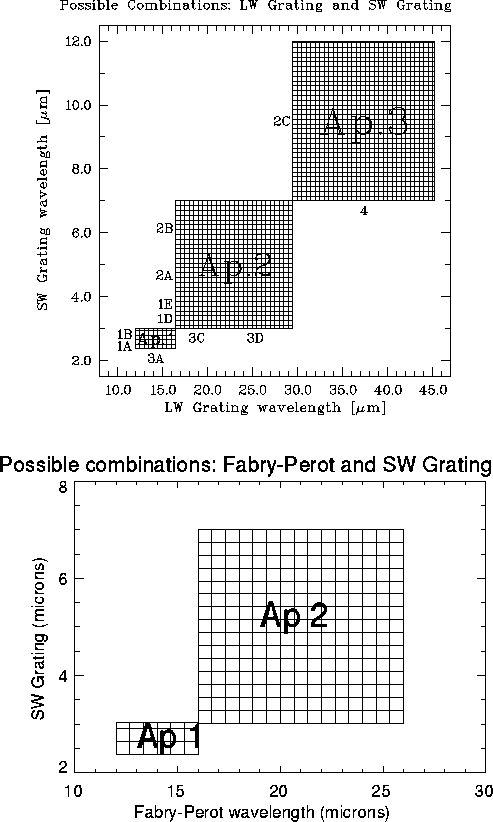The SWS is built in the form of two grating spectrometers that are
simultaneously fed via a dichroic beamsplitter. It is possible to perform
simultaneous observations in the Short Wavelength section and the Long
Wavelength section with light coming through the same entrance aperture.
Therefore, the time to execute properly planned grating observations can be
shortened significantly, and grating spectra for part of the 2.38-7 ![]() m
range may be obtained at low cost while using the Fabry-Pérot. Observations
in the range 7-12
m
range may be obtained at low cost while using the Fabry-Pérot. Observations
in the range 7-12 ![]() m with the SW grating are not carried out
simultaneously with the FP, due to a slight aperture mis-alignment between the
SW grating and the FP, but are made before aperture 3 FP observations. Hence
they cost in time. Fig. 3.1 shows the possible wavelength
combinations for grating-only observations and the possible wavelength
combinations for simultaneous F-P/grating observations. Details of the
combination process are explained in Chapter 6.
m with the SW grating are not carried out
simultaneously with the FP, due to a slight aperture mis-alignment between the
SW grating and the FP, but are made before aperture 3 FP observations. Hence
they cost in time. Fig. 3.1 shows the possible wavelength
combinations for grating-only observations and the possible wavelength
combinations for simultaneous F-P/grating observations. Details of the
combination process are explained in Chapter 6.
Serendipitous data can be expected because each of the two grating sections contains two arrays, the secondary array sampling some wavelength range determined by the settings that have been used to direct the spectral region of interest to the prime array. The wavelengths sampled by the secondary array may however not be within one of the AOT bands, so that the signal may be blocked off or be a superposition of several grating orders. If no confusion of orders has occurred, wavelength calibration will be performed. It is also possible that gain and reset time settings optimized for the signal expected on the prime array are not optimal for the secondary array.

Figure 3.1: Overview of possibilities for simultaneous use of LW grating
and SW grating (top) and F-P and SW grating (bottom). Only combinations
within the hatched area are allowed. The corresponding AOT band designations
and aperture numbers are indicated.